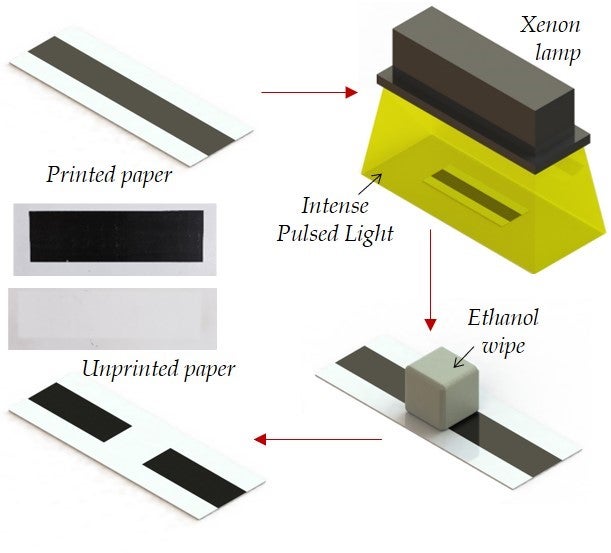
Researchers have developed a way to ‘unprint’ paper to reduce the environmental impact of recycling paper, using technology that could one day be installed in a home printer.
The method, devised by engineers at Rutgers and Oregon State University, uses a xenon lamp to blast the printed paper with intense pulsed light, a technology often used in cosmetic practices such as hair removal.
An ethanol wipe is then placed over the sheet of paper, returning a blank, undamaged sheet of paper. The researchers say that it can erase black, blue, red and green toners.
Paper is a large contributor to fossil fuel emissions, chemical pollution and energy use. The researchers posit that reusing paper multiple times in the home or office would reduce emissions associated with recycling coated paper.
Existing unprinting methods
Existing methods for unprinting involve lasers that vaporise the toner without damaging the paper. However, the laser-based method cannot work with the standard coated paper found in home and office printers.

“Our method makes it possible to unprint and then reprint on the same paper at least five times, which is typically as many times paper can be reused with conventional recycling,” said study co-author Rajiv Malhotra, an assistant professor in the Department of Mechanical and Aerospace Engineering in the School of Engineering at Rutgers University-New Brunswick.
How well do you really know your competitors?
Access the most comprehensive Company Profiles on the market, powered by GlobalData. Save hours of research. Gain competitive edge.

Thank you!
Your download email will arrive shortly
Not ready to buy yet? Download a free sample
We are confident about the unique quality of our Company Profiles. However, we want you to make the most beneficial decision for your business, so we offer a free sample that you can download by submitting the below form
By GlobalData“By eliminating the steps involved in conventional recycling, our unprinting method could reduce energy costs, pollution and greenhouse gas emissions.”
The researchers plan to improve the unprinting method so that it can be integrated into home printers, as well as testing it on a wider range of paper types.
The findings were published yesterday in the Journal of Cleaner Production.
Read more: From ocean to office: HP turns 25 million plastic bottles into printer cartridges







